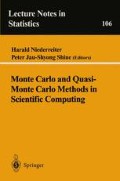Abstract
Methods for analysis of trends for the series of events have been extensively studied by many authors, both from a parametric and a nonparametric point of view. Most of the work on the development of the procedures for the nonhomoge- neous Poisson processes are based on the fixed sample size tests. It is also desirable that in some situations, interim analyses are undertaken periodically. Suppose, for example, a repairable system is under development. A development program might consist of testing to identify deficiencies, a redesign effort to correct the deficiencies, and further testing to verify these corrections and identify new problem areas. It would be advantageous to track the reliability growth trend of the system, by means of the failure data collected during development testing, so that the program could be revised, if necessary, in order to attain the system reliability objectives. Since the data often occur naturally in a sequential fashion, it will be useful to have sequential procedures allowing for repeated significance tests to the accumulating data. In this paper, we provide side-to-side information for the following two widely used test statistics in this area: (1) the well-known Laplace test (called L test), and (2) the most powerful test for the shape parameter in the Poisson process with Weibull intensity (called Z test). Discussion of major results based on a Monte Carlo simulation study include: (1) the estimated probability of type I error at or before the nth test in sampling from a simple Poisson distribution at a constant nominal level, (2) the existing support from the well-developed sequential clinical trial designs available in the literature, (3) performance assessment for abrupt changes (increasing or decreasing in the intensity of the process), and (4) a control charting procedure which presents a visual interpretation of the trend and can be practically translated for tabular or manual use in modeling the occurrences of stochastic phenomena.
Access this chapter
Tax calculation will be finalised at checkout
Purchases are for personal use only
Preview
Unable to display preview. Download preview PDF.
References
Armitage, P., McPherson, C.K., and Rowe, B.C., Repeated Significance Tests on Accumulating Data. Journal of the Royal Statistical Society, Ser. A, 132 (1969) 235 – 244.
Bain, L.J., and Engelhardt, M., Inferences on the Parameters and Current System Reliability for a Time Truncated Weibull Process, Technometrics, 22 (1980) 421 – 426.
Bain, L.J., and Engelhardt, M., Statistical Analysis of Reliability and Life-Testing Models - Theory and Methods, (2nd ed.), (1991) New York: Marcel Dekker.
Bain, L.J., Engelhardt, M., and Wright, F.T., Tests for an Increasing Trend in the Intensity of a Poisson Process: A Power Study, Journal of the American Statistical Association, 80 (1985) 419 – 422.
Bassin, W.M., Increasing Hazard Functions and Overhaul Policy, Proceedings of the 1969 Annual Symposium on Reliability, Chicago: IEEE, (1969) 173 – 178.
Cox, D.R., Some Statistical Methods Connected with Series of Events, Journal of the Royal Statistical Society, Ser. B, 17 (1955) 129 – 164.
Crow, L.H., Reliability Analysis for Complex Repairable Systems, Reliability and Biometry, eds. F. Proschan and R.J. Serfling, Philadelphia: SIAM: (1974) pp. 379 – 410.
Crow, L.H., Confidence Interval Procedures for the Weibull Process with Applications to Reliability Growth. Technometrics, 24 (1982) 67 – 72.
DeMets, D.L., and Ware, J.H., Group Sequential Methods for Clinical Trials with a One-Sided Hypothesis, Biometrika, 67 (1980) 651 – 660.
DeMets, D.L., and Ware, J.H., Asymmetric Group Sequential Boundaries for Monitoring Clinical Trials, Biometrika, 69 (1982) 661 – 663.
Finkelstein, J.M., Confidence Bounds on the Parameters of the Weibull Process. Technometrics, 18 (1976) 115 – 117.
Ho, C-H, Forward and Backward Tests for an Abrupt Change in the Intensity of a Poisson Process, Journal of Statistical Computation and Simulation, 48 (1993) 245 – 252.
Lan, K.K.G., and DeMets, D.L., Discrete Sequential Boundaries for Clinical Trials, Biometrika, 70 (1983) 659 – 663.
Lee, L., and Lee, S.K., Some Results on Inferences for the Weibull Process, Technometrics, 20 (1978) 41 – 45.
Montgomery, D.C., Introduction to Statistical Quality Control, (1985) New York: John Wiley.
O’Brien, P.C., and Fleming, T.R., A Multiple Testing Procedure for Clinical Trials, Biometrics, 35 (1979) 549 – 556.
Pocock, S.J., Group Sequential Methods in the Design and Analysis of Clinical Trials, Biometrika, 64 (1977) 191 – 199.
Ryan, T.P., Statistical Methods for Quality Improvement, (1989) New York: John Wiley.
Author information
Authors and Affiliations
Editor information
Editors and Affiliations
Rights and permissions
Copyright information
© 1995 Springer-Verlag New York, Inc.
About this paper
Cite this paper
Ho, CH. (1995). A Simulation Study of a Change-Point Poisson Process Based on Two Well-known Test Statistics. In: Niederreiter, H., Shiue, P.JS. (eds) Monte Carlo and Quasi-Monte Carlo Methods in Scientific Computing. Lecture Notes in Statistics, vol 106. Springer, New York, NY. https://doi.org/10.1007/978-1-4612-2552-2_14
Download citation
DOI: https://doi.org/10.1007/978-1-4612-2552-2_14
Publisher Name: Springer, New York, NY
Print ISBN: 978-0-387-94577-4
Online ISBN: 978-1-4612-2552-2
eBook Packages: Springer Book Archive

